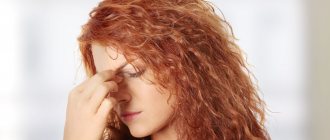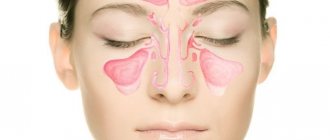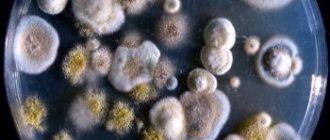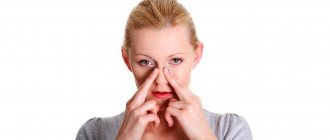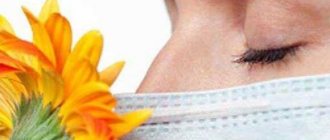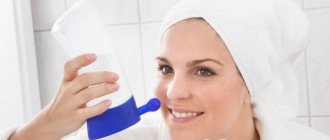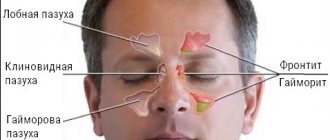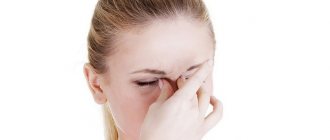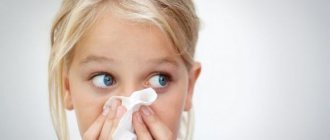Symptoms of the disease
What complicates the treatment of sinusitis is that the symptoms of this disease are quite similar to ordinary ARVI, when the child is constantly bothered by a runny nose. Therefore, the onset of any runny nose cannot be left to chance - it should be treated immediately.
ARVI, colds are a common occurrence in children. Most colds are mild in nature and do not require complex treatment. But sometimes, a runny nose does not go away for several weeks, the child becomes weak, capricious, loses his appetite, and has a headache. If you have such symptoms, you should immediately consult a specialist.
You should also see a doctor if:
- the child’s snot does not go away for a long time, even after measures have been taken;
- headache and paranasal area hurt, pain becomes stronger in the evening;
- stuffy nose, medications don’t last long, and there may not be any snot;
- the baby cannot sleep due to difficulty breathing;
- the temperature rises, the child is lethargic;
- pain in the ears, poor hearing;
- the pain spreads to the teeth.
Depending on the stage (acute or chronic sinusitis) of the disease and the individual characteristics of the baby, symptoms may differ.
It’s too early to rejoice: sinusitis and sinusitis are different
Essentially, the word “sinusitis” means an inflammatory process in the maxillary sinus. However, it can be caused not only by a viral infection (as in the case of the runny nose, which we discussed above). In addition, the “causative agents” of sinusitis (that is, the culprits of inflammation in the maxillary sinus) can also be bacteria and allergens.
Thus, sinusitis in children can be of viral, bacterial or allergic origin. Just like the runny nose itself.
When an allergic rhinitis occurs in a child (as well as in an adult), allergic sinusitis naturally occurs - after all, if swelling occurs in the nasal cavity, it is not localized only somewhere in one “corner”, it spreads to all the sinuses at once.
Both viral and allergic sinusitis go away easily, without any consequences or complications, exactly when the runny nose itself goes away.
But with bacterial sinusitis (the most severe and dangerous of all!) the situation is slightly different. As a rule, bacterial (that is, essentially purulent) sinusitis occurs when the maxillary sinus is deprived of natural ventilation. Namely: air enters the maxillary sinus through a thin tubule (and also leaves it) - that is, this cavity is constantly “ventilated”. However, if this thin tube (air channel) suddenly becomes clogged, for example, with a lump of dried mucus, then air stops flowing into the cavity. In such a “locked” environment, bacteria immediately begin to multiply, which, with the air, periodically enter any sinuses of the nose, including the maxillary sinus. Bacteria multiply and pus forms. This is the beginning of purulent sinusitis, which, unlike viral or allergic sinusitis, can actually be considered as a serious complication against the background of another disease (for example, ARVI).
If viral and allergic sinusitis often go away on their own - simultaneously with recovery from a general illness (from ARVI or an allergy attack), then purulent sinusitis almost always requires serious and surgical therapy.
Sinusitis, which goes away within three weeks, is usually called acute (acute viral, acute allergic, acute bacterial). If the maxillary sinuses are not cleared of pus within 21 days, sinusitis should already be considered chronic .
Drug treatment
How to treat sinusitis in children, what medications are the most effective? If you consult an ENT specialist in time and complete the full prescribed course of therapy, then it will be possible to get rid of sinusitis. How to quickly cure a disease and forget about it forever?
Your doctor may prescribe the following medications:
- Antibiotics (Amoxicillin, Augmentin, Azithromycin, Suprax, Sumamed, Ospamox, etc.). Antibacterial drugs will eliminate the inflammatory process. Children under 14 years of age take it in the form of a suspension or syrup, and older children take it in tablets. Current antibiotics for children do not cause much harm to the intestinal microflora, however, it is additionally necessary to consume prebiotics (Linex, Bifiform). Also, for sinusitis, topical medications (Bioparox, Isofra) are prescribed, in the form of aerosols and sprays.
- Vasoconstrictor medications (Vibrocil, Sanorin, Naphthyzin, Farmazolin, etc.). The course of treatment should not exceed 5 days.
- Decongestants (Zestra, Orinol, Fervex). These remedies help relieve swelling of the mucous membranes and are used for difficulty breathing. The most effective result will be at the beginning of the disease.
- Thinning drugs (Ambroxol, Bromhexine, Sinupret). They help to liquefy the thick purulent compartment, making it easier to drain from the sinuses. They also reduce swelling, pain, and inflammation.
- Antiseptic (Protargol, Collargol, etc.).
- Antihistamines (Loratadine, Tavegil, Diazolin). Medicines reduce swelling of the mucous membrane and increase the effect of antibiotics.
- Antipyretics (Paracetamol, Ibuprofen). Used at 38.5°C, they have an anti-inflammatory effect.
- Antiviral (Viferon, Arbidol, Cycloferon). Used for viral sinusitis.
In addition, when diagnosed with sinusitis in children, treatment is carried out using the following steps:
- Nasal rinsing with a Yamik catheter and a Cuckoo apparatus. These methods do not involve surgery. They effectively clear the nasal sinuses, wash their walls with various antiseptic solutions and relieve the symptoms of sinusitis without puncture.
- Washing at home with saline solutions. You will need a bulb or syringe to suck out the mucus.
- Physiotherapy – UHF, magnetic therapy, UV irradiation, laser therapy. Procedures can only be performed when there is no temperature. And also after treatment of the disease, when the symptoms began to decrease.
No less important how to cure sinusitis in a child is to follow some rules:
- ventilate the room and humidify the air every day;
- the house should not be very hot;
- eat only healthy and fortified foods;
- Regularly cleanse the nasal passages of pus, mucus, and crusts.
How long does it take to treat sinusitis? When therapy occurs on time, it is possible to get rid of the disease within 7-10 days.
How to treat sinusitis in a child
Medication methods
Otolaryngologists are mostly of the opinion that sinusitis and sinusitis are treated comprehensively:
- At the initial stage, nasal drops with a vasoconstrictor effect are recommended. Children need to take medications according to their age;
- It is necessary to rinse the nasal cavity with salted water. For this purpose, you can use sterile saline solution, sea water, ready-made drugs from the pharmacy, or prepare the solution yourself by dissolving ½ teaspoon of table salt in 1 liter of water;
See also on the blog: Natural antibiotics instead of pharmaceutical drugs
- to relieve swelling of the mucous membrane, antihistamines are prescribed;
- mucolytic substances will help thin mucus and facilitate its removal;
- antiseptic drugs such as isofra (a local antibiotic) and protargol, containing silver ions, have a good effect;
- To eliminate fever, antipyretic drugs are indicated (taking into account the age and body weight of the child);
- To increase immunity, the child can be given vitamins and immunomodulators.
Physiotherapy
Physiotherapeutic procedures are also useful:
- Using a salt heating pad (or another method), you need to gently warm the sinuses (the child should have a normal body temperature);
- Steam inhalations (do them under the supervision of an adult so that the child does not get burned);
- A massage that enhances lymph flow and promotes the removal of mucus and pus
In a hospital setting, the choice of physiotherapeutic procedures is quite wide, but the doctor makes the prescription.
Severe bilateral sinusitis requires antibiotic therapy.
Is it necessary to use antibiotics for sinusitis in children?
Antibiotics are prescribed by the doctor after the nasal swab is cultured and the causative agent of the disease is determined to be bacterial in nature. For viral and allergic sinusitis, treatment is done without antibiotics, since they will not have any effect.
See also on the blog: Treatment of runny nose in children, how and what to treat
The famous pediatrician Komarovsky recommends that parents not rush into antibiotics. The doctor recommends not being lazy, rinsing your nose with salt water, ventilating the room and paying attention to home hygiene and the temperature in the room. In this video, the doctor will answer whether it is necessary to treat sinusitis in the hospital?
Treatment of sinusitis with folk remedies in children
When using herbs, you need to be careful: children may react with an unexpected allergic reaction. Not all drugs suitable for treatment in adults can be used in pediatrics.
- warming up the sinuses with hard-boiled eggs and jacket potatoes. The potato mass or eggs must be wrapped in a diaper so that the child does not get burned;
- inhalation over the steam of a pan in which jacket potatoes were boiled is useful;
To relieve rhinitis and mucus discharge, the following is instilled into the nose:
- Beetroot juice diluted with warm water in a 1:1 ratio;
- Kalanchoe juice (it causes strong repeated sneezing, additionally sanitizes and disinfects the nasal cavity);
- Aloe juice;
- Sea buckthorn oil;
- Eucalyptus oil
Any of the selected drugs should be instilled 1-2 drops into each nostril 4-5 times a day.
Procedure "Cuckoo"
In children, treatment of sinusitis involves cleansing the maxillary sinuses using the “Cuckoo” method. This procedure is used for long-term illness. It is most effective for bilateral pathology. The rinsing is carried out in the hospital by an ENT doctor and is completely painless.
The procedure involves the following steps:
- a special tube is inserted into one nasal passage for the child;
- a certain disinfectant solution enters the body through this tube;
- from the second nostril, using a bulb, the solution is suctioned out along with microbes, pus, and mucus;
- during the execution, the baby says “ku-ku”, this is necessary so that the liquid does not penetrate the throat;
- Pathogenic microorganisms emerge from the nasal sinuses, as a result of which the baby’s nasal breathing is normalized.
After the first procedure, the baby will immediately feel the result, but it is still advisable to perform 5 such procedures.
Drug treatment of sinusitis in children 3 years old
Usually, catarrhal inflammation that develops against the background of ARVI goes away on its own along with the virus. There are no available drugs that could destroy the virus, but the child’s immunity is capable of defeating it itself. It just takes time, approximately 5-7 days.
What can you do to help your child?
- Regularly clear the nasal passages of accumulated mucus and help the child blow his nose.
- Use saline drops or spray. This will help cleanse the nose and moisturize the mucous membrane. The saline solution will help remove mucus from the sinuses and prevent it from thickening and further formation of pus. At 3 years old you can even rinse your nose.
- Do inhalations. Mucus often dries to the walls of the nose, causing discomfort and interfering with breathing, so to treat sinusitis in a 3-year-old child, it needs to be steamed. Let the child inhale the steam for 5 minutes several times a day. During inhalation, do not use boiling water to avoid burns. Instead of regular water, you can take a decoction of herbs (chamomile, mint, etc.).
- At high temperatures (from 38°C), use an antipyretic in the form of syrup (Coladol, Milistan, Ibunorm).
- To stimulate the immune system, give the child special medications, preferably of plant origin or homeopathy - Aflubin, Immunal, Engistol, Immunoflazide.
Do not forget about folk remedies for treating sinusitis in children. For example, make drops from aloe, cyclamen or beet juice. 1-2 times a day, you can put cotton wool pads soaked in ointment made from propolis, sea buckthorn or honey into your nose.
If the symptoms of sinusitis in children 3 years of age do not go away for more than a week or the condition worsens (for example, the temperature rises greatly), this indicates that bacteria are at the root of the problem. Typically, treatment of acute bacterial sinusitis consists of antibiotic therapy, but the above auxiliary methods should not be abandoned.
It is worth noting! Treatment of sinusitis in children 3 years old can be dangerous at home, so consultation with a doctor is required.
First of all, children are prescribed antibiotics that are active against S. pneumoniae and H. Influenza, the two most common infectious organisms that cause sinusitis. The most accessible and safe drug is Amoxicillin (Amosin) or its combination with clavulanate (Augmentin).
Children with allergies to penicillin are prescribed Azithromycin, and in cases where these drugs do not help, a more powerful antibiotic is chosen - Zinnat. For quality treatment of sinusitis, you must complete the entire course, which can last from 5 to 10 days.
If the cause of sinusitis is an allergy, the doctor will prescribe antiallergic drugs. It is also necessary to determine the allergen that provokes the child’s reaction and avoid contact with this irritant.
Repeated episodes of acute sinusitis (more than 4 times a year) are a reason to seek advice from an ENT specialist.
"Cuckoo" method
Nasal rinsing using the “cuckoo” method is often prescribed for the treatment of purulent types of sinusitis. Such procedures help to disinfect the nose, clean and moisturize it. The “cuckoo” method can be used to treat sinusitis in a child as young as 3 years old.
Washing is carried out in a lying position. Furacilin solution or another antiseptic is fed into one nostril, and a pumping device is connected to the other. Thus, the liquid moves through the nasal passages and flushes out their contents. The procedure is performed on both sides of the nose.
The name “cuckoo” comes from the fact that the patient must repeat the word “cuckoo” to prevent the liquid from getting into the throat.
Surgery for sinusitis
Surgery for sinusitis in children 3 years of age is considered for the small percentage of patients with severe or persistent sinusitis symptoms that persist despite medical therapy. Using an instrument called an endoscope, the ENT surgeon opens the natural drainage pathways of your child's maxillary sinuses and widens the narrow passages.
The procedure may include a puncture of the sinus, during which pus is removed from it. It is examined in the laboratory to determine the bacterium that caused the sinusitis. Based on these data, the patient is prescribed a suitable antibiotic. A course of anti-inflammatory drugs may also be prescribed to prevent relapses.
Additionally, your doctor may recommend removing the adenoid tissue from behind your nose. Although it does not block the sinuses, an infection called adenoiditis can cause many symptoms similar to or trigger sinusitis.
Treatment with traditional methods
It is worth noting that treatment of sinusitis in children with folk remedies should not be carried out without first consulting a doctor. Some folk recipes can provoke swelling of the nose and sinuses, thereby only harming the child. They can also cause an allergic reaction.
After consulting with a specialist, you can use the following methods:
- Take 1 tsp. propolis tincture, 1 tbsp. l. butter, mix. Cotton pads are dipped into the prepared composition and inserted into the nostril for 10 minutes. 2 times a day.
- Mix 1 spoon of chamomile flowers, the same amount of sage herb, add 500 ml of water, place in a water bath for 15 minutes. Cool slightly and perform steam inhalations with this liquid. Most often used for non-purulent forms.
- Mix aloe juice with honey. Place 3 drops into the nasal passage 3 times a day.
- Mix immortelle, centaury and tansy flowers in equal proportions. 1 tbsp. l. Pour 100 g of boiled water into this mixture, brew and leave. Dip gauze pads and apply to sinuses for 15 minutes. 2 times a day.
- 1 tbsp. l. Calendula and chamomile flowers are poured into 0.25 liters of boiled water and infused. The resulting infusion is used to rinse the nose.
- Treatment of sinusitis in children at home can be performed using infusions of eucalyptus leaves. Take 1 spoon of leaves and pour 1 cup. water, they insist. Strain, put in nose drops 3 times a day, 3 drops.
- Children over 5 years old can use honey for treatment. Take honey and Vaseline in equal quantities and mix. Cotton flagella are dipped into the resulting ointment and inserted into the nose for 30 minutes twice a day.
- Beetroot and carrot juice helps very well. The juice of any of these vegetables is dripped into the nose 3 times a day. The juice should only be freshly squeezed.
- Cyclamen root juice is diluted in a 1:1 ratio with vegetable oil. Instill 2-3 times a day, 3 drops. When instilled, a strong burning sensation occurs. However, the result will not be long in coming.
- Saline rinses have effective effects. For 200 ml of cold water, 0.5 tsp is needed. table or sea salt. You can use saline solution or sea water medicines (Aquamaris).
The benefits of traditional treatment for sinusitis
Treatment of sinusitis in children should be carried out only by a specialized specialist after a thorough examination. Several symptoms indicate the presence of inflammation in the supramandibular sinuses:
- prolonged nasal congestion;
- swelling of the cheeks and eyelids;
- headaches that get worse with movement;
- temperature increase;
- nasal discharge that has an unpleasant odor.
The beneficial properties of herbs and root vegetables have been known since ancient times. Despite this, treatment of sinusitis in children with folk remedies is used with caution. Firstly, alternative medicine is not a panacea; it is impossible to completely overcome the disease. It is used only to enhance the effect of medications. Secondly, children under 7 years of age are allergic to many plants.
But still, treating sinusitis with folk remedies has its advantages. Preparations based on honey, aloe, onion, garlic, ginger have many positive properties. They fight germs, viruses, relieve inflammation, swelling, strengthen the immune system, improve blood circulation, and are not addictive.
